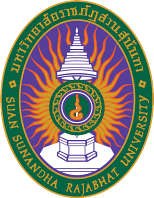A Causal Relationship Model of Factors Affecting the Effectiveness of Online Business Marketing Communications
Keywords:
A Causal Relationship Model, Marketing Communications, Online BusinessAbstract
The objectives of this study were to 1) study the factors affecting online business marketing communications and 2) develop a causal relationship model of the factors affecting online business marketing communications. It is mixed research, including quantitative research Data were collected using a questionnaire with the reliability of the entire questionnaire equal to 0.92 from 400 entrepreneurs of electronic commerce, dietary supplements, and cosmetic products. It used the Taro Yamane formula and qualitative research by conducting in-depth interviews and discussions with two groups of key informants, ten entrepreneurs and those with knowledge and expertise in marketing communications. Online marketing Administrators of famous platforms and 10 Youtuber groups analyzed data using a packaged program to find the frequency, percentage, mean, and standard deviation and Structural Equation Model Analysis (SEM).
The research found that: 1) the factors affecting online business marketing communications. The overall average was at a high level. The factor with the highest average was the digital marketing mix factors, followed by technology acceptance factor and Information technology design factor respectively, with a significant at 0.01. 2) A causal relationship model, the factors that are effective in online business marketing communications, are consistent with empirical data and are reliable and acceptable.
References
กนกวรรณ กลับวงศ์. (2562). พฤติกรรมผู้บริโภคออนไลน์ การยอมรับเทคโนโลยี และส่วนประสมทางการตลาดที่มีประสิทธิผลต่อการตัดสินใจซื้ออัญมณีเครื่องประดับผ่านสื่อออนไลน์ (วิทยานิพนธ์บริหารธุรกิจมหาบัณฑิต). มหาวิทยาลัยกรุงเทพ.
กรมพัฒนาธุรกิจการค้า. (2566). สถิติการจดทะเบียนนิติบุคคลรายจังหวัด ประจำเดือนธันวาคม 2565. ค้นเมื่อ 17 กุมภาพันธ์ 2566, จาก https://www.dbd.go.th/more_news.php?cid=1984
ชูใจ คูหารัตนไชย. (2551). สถิติเบื้องต้น. กรุงเทพฯ: สาชาสถิติประยุกต์ มหาวิทยาลัยเทคโนโลยีมหานคร.
ธวัชชัย แม่นศร. (2562). กลยุทธ์การนำเสนอสารของเฟซบุ๊กแฟนเพจบริษัททัวร์ชั้นนำของประเทศไทย (วิทยานิพนธ์ศิลปศาสตรมหาบัณฑิต). มหาวิทยาลัยรามคำแหง.
นงลักษณ์ วิรัชชัย. (2551). การวิจัยและพัฒนาตัวบ่งชี้คุณธรรมจริยธรรม. กรุงเทพฯ: ศูนย์ส่งเสริมและพัฒนา พลังแผ่นดินเชิงคุณธรรม.
พนิดา อ่อนลออ. (2559). กลยุทธ์การสื่อสารการตลาดออนไลน์ที่ทำให้ลาซาด้า (Lazada) ประสบความสำเร็จ. (วิทยานิพนธ์วารสารศาสตรมหาบัณฑิต). มหาวิทยาลัยธรรมศาสตร์.
พรพรรณ รัตนตรัยวงศ์. (2553). ปัจจัยที่มีผลต่อการเลือกใช้บริการพาณิชย์อิเล็กทรอนิกส์ของผู้ใช้อินเตอร์เน็ตในเขตจังหวัดปทุมธานี (วิทยานิพนธ์บริหารธุรกิจมหาบัณฑิต). มหาวิทยาลัยเทคโนโลยีราชมงคลธัญบุรี.
ภิเษก ชัยนิรันดร์. (2556). E-commerce และ online marketing. กรุงเทพฯ: โปรวิชั่น.
ศิริวรรณ เสรีรัตน์. (2560). กลยุทธ์การตลาด: การบริหารการตลาดยุคใหม่. กรุงเทพฯ: ไดมอนอินบิสสิเน็ตเวิร์ล.
สำนักงานพัฒนาธุรกรรมทางอิเล็กทรอนิกส์ (องค์กรมหาชน). (2562). รายงานผลการสำรวจพฤติกรรมผู้ใช้ งานอินเทอร์เน็ตในประเทศไทย พ.ศ. 2561. กรุงเทพฯ: กระทรวงดิจิทัลเพื่อเศรษฐกิจและสังคม.
สำนักงานพัฒนาธุรกรรมทางอิเล็กทรอนิกส์ (องค์การมหาชน). (2559). รายงานผลการสํารวจพฤติกรรมผู้ใช้ งานอินเทอร์ เน็ตในประเทศไทย พ.ศ. 2559. กรุงเทพฯ: กระทรวงดิจิทัลเพื่อเศรษฐกิจและสังคม.
สุณิสา ตรงจิตร์. (2559). ปัจจัยที่มีอิทธิพลต่อการตัดสินใจซื้อสินค้าออนไลน์ผ่านช่องทางตลาดกลางพาณิชย์อิเล็กทรอนิกส์ (E-Marketplace) (วิทยานิพนธ์บริหารธุรกิจมหาบัณฑิต). มหาวิทยาลัยธรรมศาสตร์.
อนัญญา เชียงกูล และภัทรภร สังขปรีชา. (2565). การสื่อสารการตลาดดิจิทัลของผู้ประกอบการธุรกิจขนาดกลางและขนาดย่อมกับการตัดสินใจเลือกใช้บริการและการจ้างงานเอเจนซีโฆษณา. วารสารนิเทศสยามปริทัศน์, 21(1), 196-209.
Arbuckle, J. J. (1995). AMOS user’s quide. Chicago: Small Waters.
Belch, G. E. & Belch, M. A. (2017). Advertising and promotion: An integrated marketing communications perspective. (19th ed.). Irwin: McGraw-Hill.
Brown, M. W. & Cudeek, R. (1993). Alliterative ways of assessing model fit, in texting structural equation model. New Jersey: Sage.
Cronbach, L. J. (2003). Essentials of Psychological Testing. (5thed.). New York: Harper Collins Publishers, Inc.
Harris, M. H. (2009). Entrepreneurship and Innovation in e-Commerce. Journal of Achievements in Materials and Manufacturing Engineering, 32(1), 92.
Hitt, M. A., Ireland, R. D., & Hoskisson, R. E. (2019). Strategic management: Competitiveness and globalization. Cincinnati, Ohio: South-Western Publishing.
Hu, Y., & Betler, R. (1999). Measuring destination attractiveness: A contextual approach. Journal of Travel Research, 32, 25-34.
Kitchen, P. J., & Pelsmacker, T. (2004). The emergence of IMC: A theoretical perspective. Journal of Advertising Research, 44(1), 20-31.
Kotler & Keller. (2016). Marketing management: The millennium. (14th ed.). New Jersey: Prentice-Hall Inc.
Tawk, C. (2021). The Manager’s Roles as Defined by Henry Mintzberg. Retrieved September 5, 2022, from https://www.meirc.com/articles/the-managers-roles-as-defined-by-henry-Mintzberg
World internet user statistics. (2020). Internet user in the world. Retrieved December, 22 2022, from http://www.internetworldstats.com/stats.htm
World Trade Organization. (1998). Definition of electronic commerce. Retrieved September 5, 2022, from https://www.wto.org/english/tratop_e/ecom_e/ecom_e.htm
Yamane, T. (1973). Statistics: an introductory analysis. New York: Harper & Row.
Downloads
Published
How to Cite
Issue
Section
License
Copyright (c) 2023 The Journal of Development Administration Research

This work is licensed under a Creative Commons Attribution-NonCommercial-NoDerivatives 4.0 International License.
บทความที่ได้รับการตีพิมพ์เป็นลิขสิทธิ์ของมหาวิทยาลัยราชภัฏสวนสุนันทา
ข้อความที่ปรากฏในบทความแต่ละเรื่องในวารสารวิชาการเล่มนี้เป็นความคิดเห็นส่วนตัวของผู้เขียนแต่ละท่านไม่เกี่ยวข้องกับมหาวิทยาลัยราชภัฏสวนสุนันทา และคณาจารย์ท่านอื่นๆ ในมหาวิทยาลัยฯ แต่อย่างใด ความรับผิดชอบองค์ประกอบทั้งหมดของบทความแต่ละเรื่องเป็นของผู้เขียนแต่ละท่าน หากมีความผิดพลาดใดๆ ผู้เขียนแต่ละท่านจะรับผิดชอบบทความของตนเองแต่ผู้เดียว



